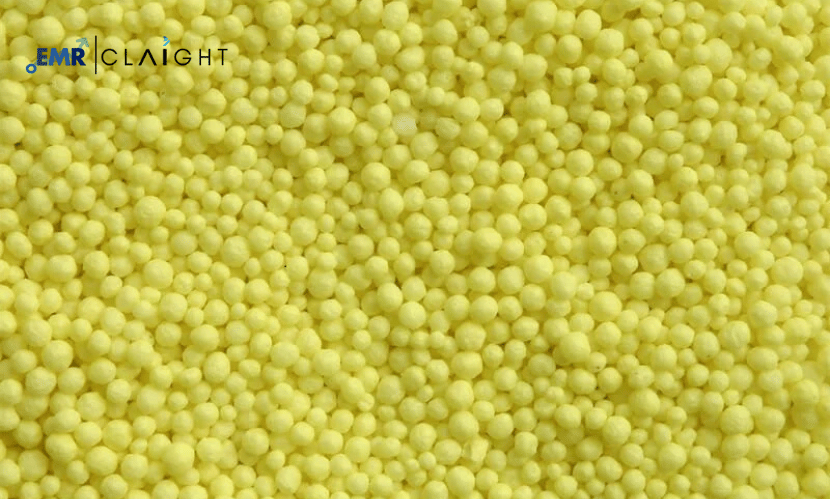Sulphur Coated Urea (SCU) is a controlled-release fertiliser designed to improve nitrogen efficiency and reduce nutrient loss in agricultural soils. By coating urea granules with sulphur, the release of nitrogen is slowed, ensuring better nutrient availability and reducing environmental impact. With the increasing demand for sustainable farming solutions, SCU has gained prominence in the agricultural sector. Setting up a manufacturing plant for SCU requires advanced technology, efficient processes, and adherence to environmental standards. This article explores the key processes, equipment, and considerations involved in establishing a successful SCU manufacturing facility.
Understanding Sulphur Coated Urea (SCU)
SCU is a fertiliser where each urea granule is encapsulated in a layer of sulphur, sometimes reinforced with a polymer or wax seal. This coating regulates the release of nitrogen into the soil, improving crop absorption and reducing leaching or volatilisation. SCU is widely used in crops requiring steady nitrogen supply and in regions with high rainfall or sandy soils.
Get a Free Sample Report with Table of Contents@ https://www.expertmarketresearch.com/prefeasibility-reports/sulphur-coated-urea-manufacturing-plant-project-report/requestsample
Key Processes in SCU Manufacturing
- Raw Material Preparation
- Urea granules are sourced and inspected for uniform size and quality. Sulphur is prepared by heating it to its liquid state for coating purposes.
- Granule Coating
- Urea granules are tumbled in a coating drum, where liquid sulphur is applied evenly. The granules are rotated to ensure uniform coating and avoid clumping.
- Wax or Polymer Application (Optional)
- To improve the durability and control the release rate, a thin layer of wax or polymer is sometimes added over the sulphur-coated granules.
- Cooling and Solidification
- The coated granules are cooled to solidify the sulphur layer, ensuring the coating is intact and durable.
- Screening and Polishing
- The coated granules are screened to remove broken or oversized particles and polished to enhance their appearance and handling properties.
- Packaging
- The final product is packed in moisture-proof bags or containers, ensuring safe storage and transport.
Essential Equipment for a Manufacturing Plant
Setting up a Sulphur Coated Urea manufacturing plant requires specialised machinery to ensure efficiency and product quality. Key equipment includes:
- Coating Drums: For applying liquid sulphur uniformly on urea granules.
- Heating Units: To melt sulphur into its liquid state for the coating process.
- Cooling Systems: For solidifying the coated granules.
- Screening Machines: To separate granules based on size and remove defective ones.
- Wax or Polymer Application Units: For adding an optional protective layer.
- Packaging Machines: For sealing and labelling the final product.
- Quality Testing Instruments: To analyse coating thickness, nitrogen release rate, and overall quality.
Designing the Plant Layout
An efficient plant layout is crucial for smooth operations and compliance with safety and environmental standards. Key considerations include:
- Raw Material Storage: Secure areas for storing urea granules and sulphur under controlled conditions.
- Processing Zones: Dedicated sections for coating, cooling, and screening processes.
- Quality Control Laboratory: Equipped for testing granule size, coating quality, and nutrient release rates.
- Packaging and Storage: Facilities for packing SCU in moisture-resistant containers and storing them securely.
- Waste Management Unit: Systems for recycling sulphur spills and managing waste responsibly.
Quality Control in SCU Manufacturing
Maintaining consistent quality is vital to ensure the effectiveness of SCU as a fertiliser. Key quality control practices include:
- Raw Material Testing: Verifying the quality and uniformity of urea granules and sulphur.
- Process Monitoring: Ensuring consistent coating thickness and uniform application of sulphur.
- Product Testing: Assessing the nitrogen release rate, durability of the coating, and granule size.
- Hygiene Standards: Implementing strict cleanliness protocols to prevent contamination.
Regulatory and Licensing Requirements
Establishing an SCU manufacturing plant requires compliance with local and international regulations. Key requirements include:
- Environmental Clearances: Adhering to regulations for emissions and waste management.
- Product Certification: Ensuring the fertiliser meets agricultural quality standards.
- Labelling Compliance: Providing accurate product information, including nutrient content and application guidelines.
- Workplace Safety Standards: Ensuring safe handling of sulphur and other raw materials.
Applications of Sulphur Coated Urea
SCU is an essential input in modern agriculture, with wide-ranging applications:
- Cereal Crops: Used in wheat, rice, and maize cultivation for sustained nitrogen availability.
- Horticulture: Ideal for fruit and vegetable farming where steady nutrient supply is crucial.
- Turf and Lawns: Popular in golf courses, sports fields, and gardens for maintaining healthy greenery.
- High-Rainfall Areas: Effective in regions prone to nutrient leaching due to heavy rains.
Sustainability in SCU Manufacturing
Sustainability is a key focus in modern fertiliser production. Measures to enhance sustainability include:
- Efficient Resource Use: Minimising waste and optimising raw material usage.
- Recycling Sulphur: Repurposing unused sulphur from other industries to reduce waste.
- Energy-Efficient Processes: Adopting machinery and technologies that lower energy consumption.
- Eco-Friendly Packaging: Using recyclable or biodegradable materials for fertiliser bags.
Market Trends and Opportunities
The demand for Sulphur Coated Urea is growing due to increasing awareness of sustainable farming practices and the need to reduce nutrient loss. Key trends include:
- Rising Adoption of Controlled-Release Fertilisers: Farmers are shifting towards SCU for its efficiency and cost-effectiveness.
- Government Support: Incentives for sustainable agriculture boost the SCU market.
- Global Expansion: High demand in emerging economies with intensive farming practices.
- Technological Advancements: Innovations in coating techniques to improve product performance and reduce costs.
Challenges in the industry include:
- Raw Material Costs: Managing fluctuations in the prices of urea and sulphur.
- Regulatory Compliance: Adapting to evolving environmental and agricultural policies.
- Market Competition: Standing out with superior product quality and cost-efficiency.
By leveraging advanced production techniques, ensuring stringent quality control, and adopting sustainable practices, manufacturers can establish a successful Sulphur Coated Urea production facility to cater to the increasing global demand for this innovative fertiliser.
